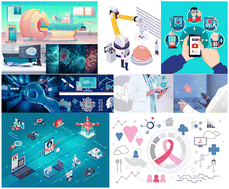Employing nano-enabled artificial intelligence (AI)-based smart technologies for prediction, screening, and detection of cancer
Abstract
Cancer has been classified as a diverse illness with a wide range of subgroups. Its early identification and prognosis, which have become a requirement of cancer research, are essential for clinical treatment. Patients have already benefited greatly from the use of artificial intelligence (AI), machine learning (ML), and deep learning (DL) algorithms in the field of healthcare. AI simulates and combines data, pre-programmed rules, and knowledge to produce predictions. Data are used to improve efficiency across several pursuits and tasks through the art of ML. DL is a larger family of ML methods based on representational learning and simulated neural networks. Support vector machines, convulsion neural networks, and artificial neural networks, among others, have been widely used in cancer research to construct prediction models that enable precise and effective decision-making. Although using these innovative methods can enhance our comprehension of how cancer progresses, further validation is required before these techniques can be used in routine clinical practice. We cover contemporary methods used in the modelling of cancer development in this article. The presented prediction models are built using a variety of guided ML approaches, as well as numerous input attributes and data collections. Early identification and cost-effective detection of cancer's progression are equally necessary for successful treatment of the disease. Smart material-based detection techniques can give end consumers a portable, affordable instrument to easily detect and monitor their health issues without the need for specialized knowledge. Owing to their cost-effectiveness, excellent sensitivity, multimodal detection capacity, and miniaturization aptitude, two-dimensional (2D) materials have a lot of prospects for clinical examination of various compounds as well as cancer biomarkers. The effectiveness of traditional devices is moving faster towards more useful techniques thanks to developments in 2D material-based biosensors/sensors. The most current developments in the design of 2D material-based biosensors/sensors—the next wave of cancer screening instruments—are also outlined in this article.

- This article is part of the themed collections: US National Nanotechnology Day 2025, Spotlight on Materials and Nano Research from Indian institutes, Recent Review Articles, Nanoscale 2024 Emerging Investigators and Machine learning and artificial neural networks: Celebrating the 2024 Nobel Prize in Physics


 Please wait while we load your content...
Please wait while we load your content...